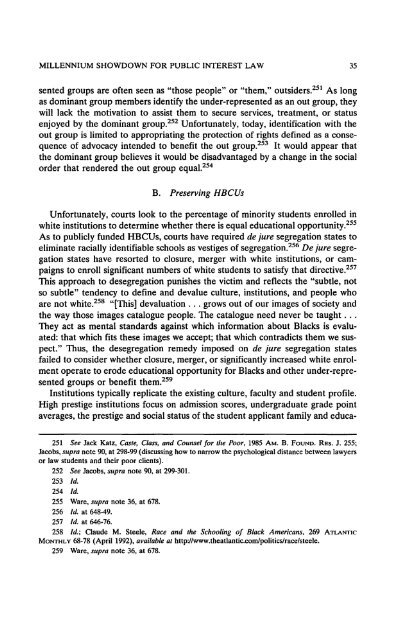Download Electronic Version - UDC Law Review
Download Electronic Version - UDC Law Review
Download Electronic Version - UDC Law Review
You also want an ePaper? Increase the reach of your titles
YUMPU automatically turns print PDFs into web optimized ePapers that Google loves.
MILLENNIUM SHOWDOWN FOR PUBLIC INTEREST LAW 35<br />
sented groups are often seen as "those people" or "them," outsiders. 25t As long<br />
as dominant group members identify the under-represented as an out group, they<br />
will lack the motivation to assist them to secure services, treatment, or status<br />
enjoyed by the dominant group.252 Unfortunately, today, identification with the<br />
out group is limited to appropriating the protection of rights defined as a consequence<br />
of advocacy intended to benefit the out group.253 It would appear that<br />
the dominant group believes it would be disadvantaged by a change in the social<br />
order that rendered the out group equa1. 254<br />
B. Preserving HBCUs<br />
Unfortunately, courts look to the percentage of minority students enrolled in<br />
white institutions to determine whether there is equal educational opportunity.255<br />
As to publicly funded HBCUs, courts have required de jure segregation states to<br />
eliminate racially identifiable schools as vestiges of segregation. 256 De jure segregation<br />
states have resorted to closure, merger with white institutions, or campaigns<br />
to enroll significant numbers of white students to satisfy that directive. 257<br />
This approach to desegregation punishes the victim and reflects the "subtle, not<br />
so subtle" tendency to define and devalue culture, institutions, and people who<br />
are not white. 258 "[This] devaluation ... grows out of our images of society and<br />
the way those images catalogue people. The catalogue need never be taught ...<br />
They act as mental standards against which information about Blacks is evaluated:<br />
that which fits these images we accept; that which contradicts them we suspect."<br />
Thus, the desegregation remedy imposed on de jure segregation states<br />
failed to consider whether closure, merger, or significantly increased white enrolment<br />
operate to erode educational opportunity for Blacks and other under-represented<br />
groups or benefit them. 259<br />
Institutions typically replicate the existing culture, faculty and student profile.<br />
High prestige institutions focus on admission scores, undergraduate grade point<br />
averages, the prestige and social status of the student applicant family and educa-<br />
251 See Jack Katz, Caste, Class, and Counsel for the Poor, 1985 AM. B. FOUND. RES. J. 255;<br />
Jacobs, supra note 90, at 298-99 (discussing how to narrow the psychological distance between lawyers<br />
or law students and their poor clients).<br />
252 See Jacobs, supra note 90, at 299-301.<br />
253 [d.<br />
254 [d.<br />
255 Ware, supra note 36, at 678.<br />
256 [d. at 648-49.<br />
257 [d. at 646-76.<br />
258 [d.; Claude M. Steele, Race and the Schooling of Black Americans, 269 ATLANTIC<br />
MONTHLY 68-78 (April 1992), available at http://www.theatlantic.comlpolitics/race/steele.<br />
259 Ware, supra note 36, at 678.














